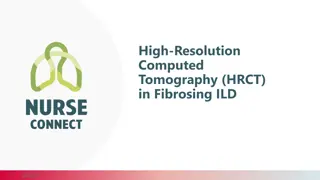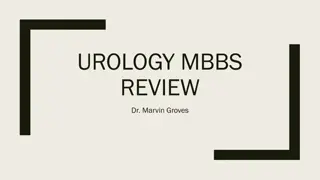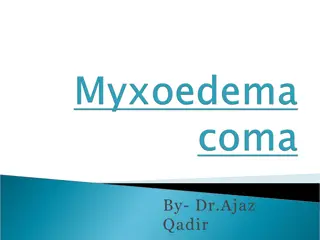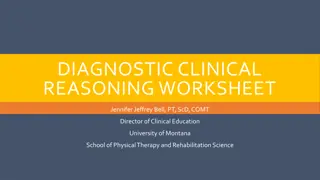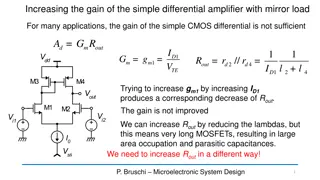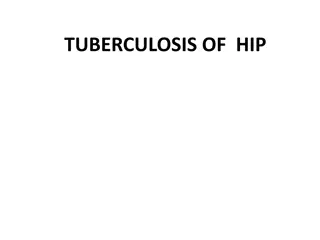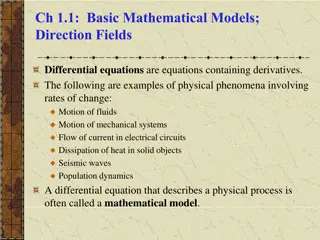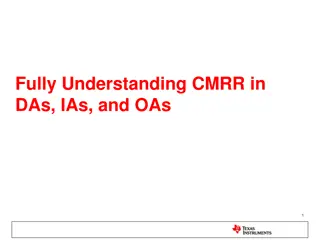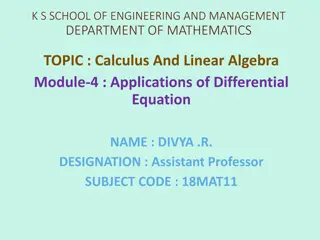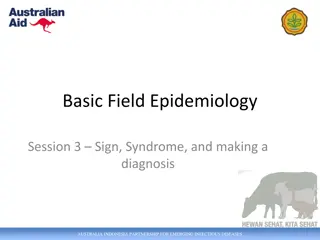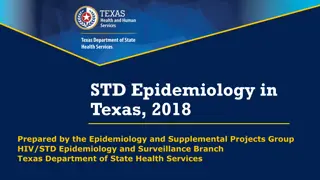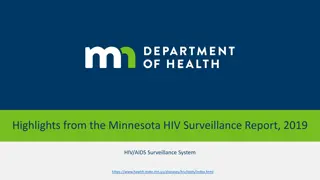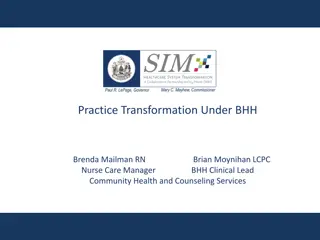Role of High-Resolution Computed Tomography in Fibrosing Interstitial Lung Diseases
HRCT plays a crucial role in diagnosing and monitoring fibrosing interstitial lung diseases (ILDs). It helps identify abnormalities not visible on X-rays, leading to early, accurate diagnoses and potentially avoiding invasive procedures. HRCT assists in distinguishing specific ILDs based on radiogra
1 views • 25 slides
Approach to Depression in Primary Care by Dr. Jon Davine
In this presentation, Dr. Jon Davine discusses the approach to depression in primary care, covering topics such as differential diagnosis, antidepressant medication selection, augmentation techniques, and treatment options like ECT and TMS. The sad state is explored through differential diagnoses, i
5 views • 56 slides
Understanding Numerical Methods for Approximating Analytic Equations
Introduction to approximating solutions to analytic equations, focusing on differential equations, integral equations, and integro-differential equations. Exploring ordinary and partial derivatives, differential and integral equations, and the involvement of unknown functions and their derivatives a
2 views • 15 slides
Potomac Horse Fever: Clinical Presentation and Diagnostic Plan
A 5-year-old Quarter Horse gelding presents with symptoms of colic and possible Potomac Horse Fever. Initial physical examination reveals sweating, tachycardia, and abnormal bowel sounds. The differential diagnoses include gastrointestinal infections, viral and bacterial causes. The diagnostic plan
1 views • 15 slides
Case Review: Diagnostic Dilemma in Urology - Management Approach for a Patient with Abdominal Pain and Fever
A 58-year-old man with a history of diabetes and hypertension presents with fever and abdominal pain, raising multiple differential diagnoses including symptomatic AAA, pyelonephritis, acute appendicitis, complicated urolithiasis, or diabetic ketoacidosis. The case explores clinical manifestations,
1 views • 35 slides
Understanding Psychotic Disorders: Insights from Schizophrenia
Explore the diagnostic criteria, neurobiological factors, and differential diagnoses of psychotic disorders, focusing on Schizophrenia. Delve into the history, epidemiology, and key characteristics of Schizophrenia to gain a comprehensive understanding of this complex mental health condition.
2 views • 107 slides
Understanding Central Abdominal Pain and Masses in Clinical Practice
Abdominal pain evaluation involves considering various differential diagnoses such as appendicitis, small bowel obstruction, and mesenteric ischemia. By categorizing pain as visceral, parietal, referred, or radiating, healthcare providers can better understand the underlying pathology. The history o
0 views • 57 slides
Differential Equations of First Order & Higher Degree: Lecture 18
This lecture covers differential equations of first order but not of the first degree, general forms of such equations, methods for solving them, and examples of differential equations to be solved. The content includes detailed explanations, equations, solutions, and problem-solving techniques.
0 views • 9 slides
Understanding WBC Differential Count in Blood Analysis
WBC (white blood cell) count is essential in assessing a patient's health. A differential count helps determine the percentage of different types of white blood cells. This analysis can provide important insights into various health conditions like infections, allergies, and systemic illnesses. The
1 views • 9 slides
Understanding Myxedema Coma: Symptoms, Diagnosis, and Management
Myxedema coma is a rare, life-threatening condition associated with decompensated hypothyroidism. It presents with altered mental status, low body temperature, and various metabolic abnormalities. This article explores the primary symptoms, differential diagnosis, and management of myxedema coma bas
0 views • 20 slides
Clinical Reasoning Worksheet for Differential Diagnoses
A Diagnostic Clinical Reasoning Worksheet created by Jennifer Jeffrey Bell, PT, ScD, COMT, to guide students through the diagnostic process, enhancing their clinical reasoning skills. The worksheet helps in selecting appropriate diagnoses based on patient demographics, describing patient presentatio
0 views • 9 slides
Understanding Differential Leveling in Surveying
Differential leveling is a crucial aspect of surveying that involves determining the elevation of points with respect to a reference datum. This process includes various key elements such as benchmark, back sight, fore sight, and change points. By utilizing methods like the Height of Instrument and
1 views • 12 slides
Techniques to Increase Gain in a Simple Differential Amplifier
Explore methods to boost the gain of a simple CMOS differential amplifier by replacing the current mirror with a cascode mirror, adding a common-gate stage, and employing a cascode differential amplifier. These techniques help improve Rout without extensive use of long MOSFETs, optimizing the amplif
2 views • 30 slides
Understanding Mediastinal Masses: A Comprehensive Visual Guide
Explore detailed visuals and descriptions of mediastinal masses, compartments, x-ray densities, and key signs in diagnosis. Learn about different types of masses and their management, including common differential diagnoses and imaging techniques.
1 views • 23 slides
Understanding Differential Equations: Types, Classification, and Solutions
Differential equations are mathematical equations that relate independent and dependent variables through differential coefficients. They can be classified as ordinary or partial, based on the types of derivatives involved. The order and degree of a differential equation, as well as its linearity an
2 views • 26 slides
Understanding Differential Equations in Economics Honours
Differential equations, introduced by Newton and Leibniz in the 17th century, play a key role in economics. These equations involve derivatives and represent implicit functional relationships between variables and their differentials, often related to time functions. The order and degree of a differ
1 views • 16 slides
Introduction to Differential Equations and Laplace Equations
Understanding differential equations of various orders, solving methods, linear and non-linear equations, ordinary and partial differential equations, definitions of solutions, and general vs. particular solutions in the context of Differential Equations and Laplace Equations.
1 views • 20 slides
Polymyalgia and Giant Cell Arteritis Overview
This informative content covers key clinical features, investigations, management, and differential diagnoses of Polymyalgia Rheumatica and Giant Cell Arteritis. It includes details on PMR and GCA guidelines, core clinical features, signs indicating other causes, possible differentials, and recommen
2 views • 25 slides
Neonatal Vomiting: Causes, Diagnosis, and Differential Diagnosis
Neonatal vomiting can be a concern when presenting with bile-stained or blood-stained vomit, projectile vomiting, or associated with weight loss and failure to grow. Various non-surgical and surgical conditions like Pyloric Stenosis can lead to vomiting in neonates. Common causes include Mid-gut vol
0 views • 16 slides
Understanding Tuberculosis of Hip and Knee Joint Deformities
Tuberculosis can affect the hip and knee joints, leading to various deformities and complications if left untreated. Common sites of TB in knee joint, neglected cases due to hamstring contracture, path mechanics of deformity development, along with differential diagnoses and treatment options are di
0 views • 8 slides
Understanding ICD-11 and Morbidity Coding Principles
ICD-11 is a classification system that groups entities based on statistical relevance and specificity of codes. Entities without specific codes are assigned to residual codes (Y for specified, Z for unspecified) based on hierarchy. Examples illustrate the differentiation between specified and unspec
0 views • 15 slides
Understanding Differential Equations in Physical Phenomena
Differential equations play a crucial role in modeling physical phenomena involving rates of change like fluid motion, mechanical systems, and heat dissipation. This content explores examples of differential equations in motion and provides insights on sketching direction fields using tools like Map
0 views • 11 slides
Understanding Nursing Diagnoses and Interventions in Healthcare
Exploring the evolution of nursing diagnoses from the 1950s to the present day, this content highlights the importance of accurate diagnostic reasoning in creating effective care plans. It covers the types of nursing diagnoses, problem identification, etiology, and signs/symptoms, emphasizing the si
1 views • 27 slides
Comprehensive Overview of Parotid Tumor Diagnosis and Management
This comprehensive guide covers the diagnosis and management of parotid tumors, including anatomy, differential diagnosis, and management strategies. It discusses the approach to evaluating patients with neck lumps, differential diagnoses to consider, and the management techniques for both benign an
0 views • 20 slides
Exploring SymDiff: A Differential Program Verifier
SymDiff is a platform that leverages program verification to analyze program differences, focusing on differential verification to verify properties of program variances rather than the program itself. The architecture, language subset, and modeling imperative programs/heaps are key components discu
1 views • 18 slides
Understanding Eating Disorders in Children by Dr. Soumi Kundu
Eating disorders in children, such as anorexia nervosa, bulimia nervosa, and binge eating disorder, are complex biopsychosocial disorders characterized by dysfunctional patterns of cognition and weight control behaviors. They result in significant physical, psychological, and social complications. T
0 views • 34 slides
Understanding CMRR in Differential Amplifiers
Differential input amplifiers, including operational, instrumentation, and difference amplifiers, play a crucial role in amplifying differential signals while rejecting common-mode noise. The Common-Mode Rejection Ratio (CMRR) is a key parameter in these amplifiers, indicating their ability to suppr
0 views • 48 slides
Applications of Differential Equations in Engineering and Mathematics
Exploring the practical applications of differential equations, specifically focusing on Newton's Law of Cooling and Orthogonal Trajectories. The concept of exact differential equations and their solutions, along with real-life examples demonstrating temperature changes over time, are discussed. Und
0 views • 11 slides
Understanding Non-Alzheimer Dementias: Cases and Diagnoses
Explore intriguing clinical cases and differential diagnoses related to non-Alzheimer dementias, including symptoms, evaluations, and potential treatments. From B12 deficiency to vascular dementia, unravel the complexities of cognitive impairments in varied scenarios.
0 views • 28 slides
Understanding Signs, Syndromes, and Diagnoses in Epidemiology Session
Explore the significance of signs of disease, syndromes, and making accurate diagnoses in the context of the Australia-Indonesia Partnership for Emerging Infectious Diseases. Engage in activities to differentiate between signs and syndromes, identify characteristics of healthy and unhealthy animals,
0 views • 18 slides
Advanced HIV Diagnoses Among Gay and Bisexual Men in Australia: 2007-2016 Study Analysis
This study conducted in Australia from 2007-2016 analyzed advanced HIV diagnoses among gay and bisexual men. The research identified factors like age (30-39, 40-49, 50-59, 60+), exposure type (bisexual, MSM + IDU), and region of birth (South East Asia and North East Asia) as significant contributors
0 views • 6 slides
Understanding Differential Privacy in Statistical Analysis
Gain insight into the concept of differential privacy in statistical analysis through key terminologies, foundational ideas, and practical examples. Explore the balance between data privacy and statistical quality, and learn how differential privacy serves as a mathematical guarantee to protect indi
1 views • 28 slides
STD Epidemiology in Texas: A Data Analysis from 1992-2018
The report presents data on chlamydia and gonorrhea diagnoses in Texas from 1992 to 2018, highlighting trends in cases, demographics, and incidence rates by county. It also showcases chlamydia diagnoses among women by race/ethnicity during the period 2009-2018. The information sheds light on the epi
0 views • 18 slides
Dynamic Function for Basal Area of Trees Derived from Differential Equation
Mathematical methods presented by Braun and Simmons are used to derive a dynamic function for the basal area of individual trees from a production-theoretically motivated autonomous differential equation. The differential equation and general dynamic function are described, highlighting the relation
0 views • 45 slides
Solving Differential Equations: Methods and Techniques
Learn how to solve differential equations using methods like separation of variables and sketch families of solution curves. Understand the process of finding general and particular solutions to equations, and explore a variety of exercises and examples to enhance your understanding. Master the art
0 views • 16 slides
Efficient Medical History Taking Guidelines
Medical history taking is a crucial step in diagnosis, involving the patient's account of illness and relevant information. Following a structured framework helps identify potential diagnoses. Key elements include personal information, chief complaint, presenting illness history, review of systems,
0 views • 51 slides
STI Surveillance in Northern Ireland 2019: Analysis of Data for Year 2018
This report presents an analysis of sexually transmitted infection (STI) surveillance data in Northern Ireland for the calendar year 2018. It includes trends in diagnoses, sexual health screens, new diagnoses of STIs, chlamydial infection diagnoses, referral sources of specimens, laboratory reports
0 views • 19 slides
The Challenges of Protecting Privacy with Differential Privacy
The article discusses the motivation behind using differential privacy to protect sensitive data while enabling useful queries. It highlights the promise of differential privacy, challenges faced, attacks on existing systems like PINQ and Airavat, and introduces a defense system called The Fuzz. The
0 views • 24 slides
Insights from Minnesota HIV Surveillance Report, 2019
Detailed data on HIV diagnoses in Minnesota in 2019, including new diagnoses, disease trends, cases by county, and population breakdown by race/ethnicity and sex assigned at birth. The report also covers rates of HIV diagnoses, risk factors, and provides a snapshot of the HIV/AIDS situation in Minne
0 views • 21 slides
Enhancing Healthcare Outcomes through Behavioral Health Homes (BHH) at CHCS
Learn about the benefits of having a BHH at CHCS, including improved coordination of care, mitigation of medical issues contributing to mental illness, and better identification of client needs. With a team approach, BHH allows for addressing medical diagnoses and reducing unnecessary ER visits. Dis
0 views • 7 slides
